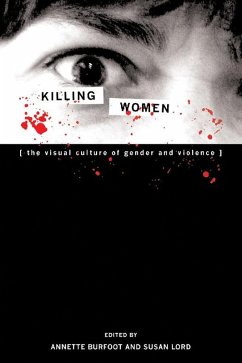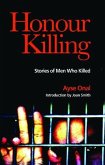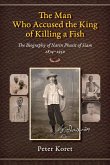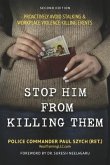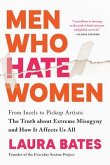Killing Women
The Visual Culture of Gender and Violence
Herausgeber: Burfoot, Annette; Lord, Susan
Killing Women
The Visual Culture of Gender and Violence
Herausgeber: Burfoot, Annette; Lord, Susan
- Broschiertes Buch
- Merkliste
- Auf die Merkliste
- Bewerten Bewerten
- Teilen
- Produkt teilen
- Produkterinnerung
- Produkterinnerung
The essays in Killing Women: The Visual Culture of Gender and Violence find important connections in the ways that women are portrayed in relation to violence, whether they are murder victims or killers. The book's extensive cultural contexts acknowledge and engage with contemporary theories and practices of identity politics and debates about the ethics and politics of representation itself. Does representation produce or reproduce the conditions of violence? Is representation itself a form of violence? This book adds significant new dimensions to the characterization of gender and violence…mehr
Andere Kunden interessierten sich auch für
![Honour Killing Honour Killing]() Ayse OnalHonour Killing18,99 €
Ayse OnalHonour Killing18,99 €![Killing in the Name of Identity Killing in the Name of Identity]() Vamik D VolkanKilling in the Name of Identity18,99 €
Vamik D VolkanKilling in the Name of Identity18,99 €![The Man Who Accused the King of Killing a Fish The Man Who Accused the King of Killing a Fish]() Peter KoretThe Man Who Accused the King of Killing a Fish36,99 €
Peter KoretThe Man Who Accused the King of Killing a Fish36,99 €![Killing African Americans Killing African Americans]() Noel A CazenaveKilling African Americans56,99 €
Noel A CazenaveKilling African Americans56,99 €![Stop Him from Killing Them: Proactively Avoid Stalking & Workplace Violence Killing Events Stop Him from Killing Them: Proactively Avoid Stalking & Workplace Violence Killing Events]() Szych (Ret) Police Commander Paul .Stop Him from Killing Them: Proactively Avoid Stalking & Workplace Violence Killing Events15,99 €
Szych (Ret) Police Commander Paul .Stop Him from Killing Them: Proactively Avoid Stalking & Workplace Violence Killing Events15,99 €![Consistently Opposing Killing Consistently Opposing Killing]() Consistently Opposing Killing17,99 €
Consistently Opposing Killing17,99 €![Men Who Hate Women Men Who Hate Women]() Laura BatesMen Who Hate Women17,99 €
Laura BatesMen Who Hate Women17,99 €-
-
-
The essays in Killing Women: The Visual Culture of Gender and Violence find important connections in the ways that women are portrayed in relation to violence, whether they are murder victims or killers. The book's extensive cultural contexts acknowledge and engage with contemporary theories and practices of identity politics and debates about the ethics and politics of representation itself. Does representation produce or reproduce the conditions of violence? Is representation itself a form of violence? This book adds significant new dimensions to the characterization of gender and violence by discussing nationalism and war, feminist media, and the depiction of violence throughout society.
Hinweis: Dieser Artikel kann nur an eine deutsche Lieferadresse ausgeliefert werden.
Hinweis: Dieser Artikel kann nur an eine deutsche Lieferadresse ausgeliefert werden.
Produktdetails
- Produktdetails
- Verlag: Wilfrid Laurier University Press
- Seitenzahl: 354
- Erscheinungstermin: 1. Oktober 2006
- Englisch
- Abmessung: 229mm x 150mm x 15mm
- Gewicht: 454g
- ISBN-13: 9780889204973
- ISBN-10: 0889204977
- Artikelnr.: 27013878
- Herstellerkennzeichnung
- Libri GmbH
- Europaallee 1
- 36244 Bad Hersfeld
- gpsr@libri.de
- Verlag: Wilfrid Laurier University Press
- Seitenzahl: 354
- Erscheinungstermin: 1. Oktober 2006
- Englisch
- Abmessung: 229mm x 150mm x 15mm
- Gewicht: 454g
- ISBN-13: 9780889204973
- ISBN-10: 0889204977
- Artikelnr.: 27013878
- Herstellerkennzeichnung
- Libri GmbH
- Europaallee 1
- 36244 Bad Hersfeld
- gpsr@libri.de
Table of Contents for
Killing Women: The Visual Culture of Gender and Violence, edited by Annette
Burfoot and Susan Lord
Illustrations
Acknowledgments
Introduction Annette Burfoot and Susan Lord
Section 1: History, Memory, and Mediations of Murder
1. Mapping Scripts and Narratives of Women Who Kill Their Husbands in
Canada, 1866-1954: Inscribing the Everyday Sylvie Frigon
2. Neither Forgotten Nor Fully Remembered: Tracing an Ambivalent Public
Memory on the Tenth Anniversary of the Montreal Massacre Sharon Rosenberg
3. Missing: On the Politics of Re/Presentation Zoey Elouard Michele
4. Killing the Killers: Women on Death Row in the United States Kathleen
O'Shea
5. "Dealing with the Devil": Karla Homolka and the Absence of Feminist
Criticism Belinda Morrissey
Section 2: Techniques and Technologies of Representing Violence
6. Pearls and Gore: The Spectacle of Woman in Life and Death Annette
Burfoot
7. "I Am Awake in the Place Where Women Die": Violent Death in the Art of
Abigail Lane and Jenny Holzer Lisa Coulthard
8. Women and Murder in the Televirtuality Film Jack Boozer
9. "I'm in There! I'm One of the Women in That Picture" Margot Leigh
Butler
10. Killing Time: The Violent Imaginary of Feminist Media Susan Lord
Section 3: National Trouble: Gendered Violence
11. Dario Argento's The Bird with the Crystal Plumage: Caging Women's Rage
Frank Burke
12. How Positively Levitating! Chinese Heroines of Kung Fu and Wuxia Pian
Suzie S.F. Young
13. The Madwomen in Our Movies: Female Psycho-Killers in American Horror
Cinema Steven Jay Schneider
14. Reverence, Rape-and then Revenge: Popular Hindi Cinema's "Women's Film"
Jyotika Virdi
15. In the Name of the Nation: Images of Palestinian and Israeli Women
Fighters Dorit Naaman
Sources
Biographical Notes
Index
List of Illustrations
Women prisoners at cells (possibly Kingston Penitentiary), c 1900
"La Corriveau," cartoon depicting the public exhibition of Madame Corriveau
Charlotte Corday by Louis Muller, c 1880
Prisoner dressed up with poodle at Kingston Prison for Women, c 1950
Bench, Marker of Change-Natalie Croteau, Vancouver
Bench, Marker of Change-indentation from top, Vancouver
Nave for Fourteen Queens-"G" in Steel, Montreal
Nave for Fourteen Queens-Steel Pillars in Snow, Montreal
Plaque-Ecole Polytechnique, Montreal
Angels softball team, Kingston Prison for Women, 1950s
Prisoner ballet dancing at Kingston Prison for Women, 1950s
Kitchen at Kingston Prison for Women, 1961
"The Skinned Man," wax anatomical figure from La Specola, Florence, Italy,
c 1785
"Woman Holding Her Plait," wax anatomical figure from La Specola, Florence,
Italy, c 1785
"The Doll," wax anatomical figure from La Specola, Florence, Italy, c 1785
"Dissected Uterus with Twins at Term," wax anatomical figure from La
Specola, Florence, Italy, c 1785
"Beribboned Penis," wax anatomical figure from La Specola, Florence, Italy,
c 1785
Billboard from "nhi-No Humans Involved" artists' project, San Diego, 1992
Gallery installation from "nhi-No Humans Involved" artists' project, San
Diego, 1992
Scene from Semiotics of the Kitchen, 1974
Scene from The Smiling Madame Beudet, 1923
Scene from The Smiling Madame Beudet, 1923
Scene from Broken Mirrors, 1984
Scene from The Book of Knives, 1996
Scene from The Book of Knives, 1996
Prisoners' glee club, Kingston Prison for Women, 1955
Mills Eisert escape site, Kingston Prison for Women, 1961
Scene from Teesri Manzil/Third Floor, 1965
Scene from Insaaf ka Taraazu/Scales of Justice, 1980
Scene from The Battle of Algiers, 1965
Scene from The Battle of Algiers, 1965
Dead woman holding flag in hand, from Hill 24 Doesn't Answer, 1955
Dead woman covered with flag, from Hill 24 Doesn't Answer, 1955
Scene from Exodus, 1960
Prisoners tap dancing at Christmas concert, Kingston Prison for Women, 1952
Contributors' Bios
Jack Boozer is a professor in the Department of Communication at Georgia
State University, where he teaches film studies, screenwriting, and
adaptation. He has published widely on American film, including Career
Movies: American Business and the Success Mystique. His work on individual
films includes articles on The Crying Game, Thelma and Louise, and the
history of femmes fatales. He is currently completing an edited book, The
Process of Adaptation. His forthcoming articles include one on the year
1987 in Hollywood film for a series by Rutgers University Press.
Annette Burfoot is an associate professor in the Department of Sociology,
Queen's University,Kingston. She has published in the sociology of science
and technology (as editor of The Encyclopedia of Reproductive Technologies
) and on the representation of gender in science fiction and
science-as-fact. She currently studies the formation of modern medical
imaging as a historical cultural science study from the point of view of
feminist materialism.
Frank Burke is a professor of Film at Queen's University,Kingston. He has
published Federico Fellini: Variety Lights to La Dolce Vita and Fellini's
Films: From Postwar to Postmodern and has co-edited Federico Fellini:
Contemporary Perspectives. He provided the commentary (along with Peter
Brunette) for the 2006 Criterion DVD release of Fellini's Amarcord. He has
published numerous essays on Italian and North American cinema and is
currently writing a book for Edinburgh University Press on the Italian
sword-and-sandal film of the 1950s and 1960s.
Margot Leigh Butler is a theorist, installation artist, and cultural
activist. She has a Ph.D. in Media and Communications from Goldsmiths
College,University of London, UK, with specializations in politics,
philosophy, art, and science and technology studies.Her work has been
published in Women's Studies International Forum, West Coast Line, The
Virtual Embodied, and elsewhere. She lectures in Europe and Canada and is
part of the Kootenay School of Writing collective. She lives in Vancouver,
where she is curating a reading series called "'Tag, we're it!' or
'Implicatedness.'"
Lisa Coulthard is an assistant professor of Film Studies at the University
of British Columbia, Vancouver. She has published on Quentin Tarantino,
John Woo,Abigail Lane, Kiki Smith, and Stan Douglas. She is currently
working on a manuscript on love in contemporary European cinema.
Sylvie Frigon holds a Ph.D. from the Institute of Criminology at the
University of Cambridge, UK. She is Professor and outgoing Chair of the
Department of Criminology at the University of Ottawa. She has co-edited
(with Michèle Kérisit) Du corps des femmes: contrôles, surveillances et
résistances. She edited a special issue of the journal Criminologie:
"L'enfermement des femmes au Canada: une décennie de réformes" and authored
the book L'homicide conjugal au féminin: d'hier à aujourd'hui. She has also
published a novel, Écorchées, on women in prison. She is currently working
with Chris Bruckert and Nathalie Duhamel on the social and professional
(re)integration of women in conflict with the law and on the issue of
mental health of women during and after imprisonment. Dr. Frigon founded
the research and action alliance La Corriveau, which is concerned with
socially marginalized and criminalized women. She is finishing a manuscript
on the body and imprisonment for the Autrement collection in Paris and is
writing a book on dance, the body, and imprisonment with Claire Jenny,
choreographer and director of the Parisian dance company Point Virgule.
Susan Lord teaches film and media cultures at Queen's University in
Kingston. Her main research areas are women's film culture, Cuban visual
culture, new media, and translocal artist collectives. She is co-editor
with Janine Marchessault of Fluid Screens, Expanded Cinema and co-editor of
Digital Poetics and Politics, a special issue of the journal Public. She
has published widely on women's film cultures. She is completing a
manuscript about Sara Gómez and Cuban documentary in the 1960s.
Zoey Élouard Michele wrote her chapter in this volume, "Missing: On the
Politics of Re/Presentation," while enrolled as a doctoral student in the
Department of Sociology at Queen's University in Kingston, Ontario. In
2005, she left academic life to pursue a career in the skilled trades. She
lives in Halifax, Nova Scotia, with her husband, René.
Belinda Morrissey teaches media and communication studies at the University
of Canberra, Australia. She is the author of When Women Kill: Questions of
Agency and Subjectivity, and has published articles in several journals,
including Social Semiotics, Continuum, and Australian Women's Law Journal.
She is the author of a chapter in the forthcoming Inflections of Everyday
Life.
Dorit Naaman is a film theorist and documentarist from Jerusalem and
teaches at Queen's University, Canada. Her research focuses on Middle
Eastern cinemas (primarily from post-colonialist and feminist
perspectives), and she is currently working on a book on the visual
representation of Palestinian and Israeli women fighters. Her documentary
work is about identity politics and the politics of representation, and she
developed a format of short videos, DiaDocuMEntaRY.
Kathleen A. O'Shea, a nun for thirty years, is a social worker who does
research on female offenders, with an emphasis on women on death row. She
is a teacher, writer, activist, and lecturer with a great passion for what
she does. She published Female Offenders: An Annotated Bibliography, Women
and the Death Penalty in the United States: 1900-1998, and Women on the
Row: Revelations from Both Sides of the Bars. She has recently finished a
collection of stories of nuns who have befriended death row inmates. She
lives and works at Innisfree Village, a lifetime facility for mentally
handicapped adults in rural Virginia, and is currently working on Hymns of
the Revolution, a novel based on her memoirs of Chile, 1965-1973.
Sharon Rosenberg is an associate professor at the University of Alberta,
Edmonton, where she teaches in the theory/culture focus of the Department
of Sociology. She works primarily in the areas of contemporary feminist and
queer theorizing, trauma and memory studies, and pedagogy and culture. She
is the editor of the special issue "Memorializing Queers/Queering
Remembrances," for torquere: Journal of the Canadian Lesbian and Gay
Studies Association; is co-author of Troubling Women's Studies: Pasts,
Presents and Possibilities, with A. Braithwaite, S. Heald, and S. Luhmann,
and is co-editor of Between Hope and Despair: Pedagogy and the Remembrance
of Historical Trauma, with R. Simon and C. Eppert. Rosenberg's current
research considers the possibilities for non-indifference as a mode of
living with and in regard for the legacies of those who have died
violently.
Steven Jay Schneider is a Ph.D. candidate in Cinema Studies at New York
University's Tisch School of the Arts. His books include Horror
International, Fear without Frontiers: Horror Cinema across the Globe, New
Hollywood Violence, Horror Film and Psychoanalysis: Freud's Worst
Nightmares, Dark Thoughts: Philosophic Reflections on Cinematic Horror,
Underground USA: Filmmaking beyond the Hollywood Canon, Traditions in World
Cinema, and 1001 Movies You Must See Before You Die.
Jyotika Virdi, assistant professor at the University of Windsor, Ontario,
teaches film/media studies. Her research interests include postcolonial
cultural politics, and she has published essays in Film Quarterly, Jump Cut
, Screen, and Visual Anthropology. Her book, The Cinematic ImagiNation:
Social History through Indian Popular Films, is forthcoming from Rutgers
University Press. Suzie Sau-Fong Young is an associate professor of
cultural theory and film studies at York University, Toronto. She has an
interest in practices of "place" (digital diaspora, national cinemas),
inscriptions of "body" (cinematernity, Nature-tv), and theories of the
"grotesque" (the pleasures of horror/David Cronenberg, the horrors of
pleasure/Steven Spielberg).
Killing Women: The Visual Culture of Gender and Violence, edited by Annette
Burfoot and Susan Lord
Illustrations
Acknowledgments
Introduction Annette Burfoot and Susan Lord
Section 1: History, Memory, and Mediations of Murder
1. Mapping Scripts and Narratives of Women Who Kill Their Husbands in
Canada, 1866-1954: Inscribing the Everyday Sylvie Frigon
2. Neither Forgotten Nor Fully Remembered: Tracing an Ambivalent Public
Memory on the Tenth Anniversary of the Montreal Massacre Sharon Rosenberg
3. Missing: On the Politics of Re/Presentation Zoey Elouard Michele
4. Killing the Killers: Women on Death Row in the United States Kathleen
O'Shea
5. "Dealing with the Devil": Karla Homolka and the Absence of Feminist
Criticism Belinda Morrissey
Section 2: Techniques and Technologies of Representing Violence
6. Pearls and Gore: The Spectacle of Woman in Life and Death Annette
Burfoot
7. "I Am Awake in the Place Where Women Die": Violent Death in the Art of
Abigail Lane and Jenny Holzer Lisa Coulthard
8. Women and Murder in the Televirtuality Film Jack Boozer
9. "I'm in There! I'm One of the Women in That Picture" Margot Leigh
Butler
10. Killing Time: The Violent Imaginary of Feminist Media Susan Lord
Section 3: National Trouble: Gendered Violence
11. Dario Argento's The Bird with the Crystal Plumage: Caging Women's Rage
Frank Burke
12. How Positively Levitating! Chinese Heroines of Kung Fu and Wuxia Pian
Suzie S.F. Young
13. The Madwomen in Our Movies: Female Psycho-Killers in American Horror
Cinema Steven Jay Schneider
14. Reverence, Rape-and then Revenge: Popular Hindi Cinema's "Women's Film"
Jyotika Virdi
15. In the Name of the Nation: Images of Palestinian and Israeli Women
Fighters Dorit Naaman
Sources
Biographical Notes
Index
List of Illustrations
Women prisoners at cells (possibly Kingston Penitentiary), c 1900
"La Corriveau," cartoon depicting the public exhibition of Madame Corriveau
Charlotte Corday by Louis Muller, c 1880
Prisoner dressed up with poodle at Kingston Prison for Women, c 1950
Bench, Marker of Change-Natalie Croteau, Vancouver
Bench, Marker of Change-indentation from top, Vancouver
Nave for Fourteen Queens-"G" in Steel, Montreal
Nave for Fourteen Queens-Steel Pillars in Snow, Montreal
Plaque-Ecole Polytechnique, Montreal
Angels softball team, Kingston Prison for Women, 1950s
Prisoner ballet dancing at Kingston Prison for Women, 1950s
Kitchen at Kingston Prison for Women, 1961
"The Skinned Man," wax anatomical figure from La Specola, Florence, Italy,
c 1785
"Woman Holding Her Plait," wax anatomical figure from La Specola, Florence,
Italy, c 1785
"The Doll," wax anatomical figure from La Specola, Florence, Italy, c 1785
"Dissected Uterus with Twins at Term," wax anatomical figure from La
Specola, Florence, Italy, c 1785
"Beribboned Penis," wax anatomical figure from La Specola, Florence, Italy,
c 1785
Billboard from "nhi-No Humans Involved" artists' project, San Diego, 1992
Gallery installation from "nhi-No Humans Involved" artists' project, San
Diego, 1992
Scene from Semiotics of the Kitchen, 1974
Scene from The Smiling Madame Beudet, 1923
Scene from The Smiling Madame Beudet, 1923
Scene from Broken Mirrors, 1984
Scene from The Book of Knives, 1996
Scene from The Book of Knives, 1996
Prisoners' glee club, Kingston Prison for Women, 1955
Mills Eisert escape site, Kingston Prison for Women, 1961
Scene from Teesri Manzil/Third Floor, 1965
Scene from Insaaf ka Taraazu/Scales of Justice, 1980
Scene from The Battle of Algiers, 1965
Scene from The Battle of Algiers, 1965
Dead woman holding flag in hand, from Hill 24 Doesn't Answer, 1955
Dead woman covered with flag, from Hill 24 Doesn't Answer, 1955
Scene from Exodus, 1960
Prisoners tap dancing at Christmas concert, Kingston Prison for Women, 1952
Contributors' Bios
Jack Boozer is a professor in the Department of Communication at Georgia
State University, where he teaches film studies, screenwriting, and
adaptation. He has published widely on American film, including Career
Movies: American Business and the Success Mystique. His work on individual
films includes articles on The Crying Game, Thelma and Louise, and the
history of femmes fatales. He is currently completing an edited book, The
Process of Adaptation. His forthcoming articles include one on the year
1987 in Hollywood film for a series by Rutgers University Press.
Annette Burfoot is an associate professor in the Department of Sociology,
Queen's University,Kingston. She has published in the sociology of science
and technology (as editor of The Encyclopedia of Reproductive Technologies
) and on the representation of gender in science fiction and
science-as-fact. She currently studies the formation of modern medical
imaging as a historical cultural science study from the point of view of
feminist materialism.
Frank Burke is a professor of Film at Queen's University,Kingston. He has
published Federico Fellini: Variety Lights to La Dolce Vita and Fellini's
Films: From Postwar to Postmodern and has co-edited Federico Fellini:
Contemporary Perspectives. He provided the commentary (along with Peter
Brunette) for the 2006 Criterion DVD release of Fellini's Amarcord. He has
published numerous essays on Italian and North American cinema and is
currently writing a book for Edinburgh University Press on the Italian
sword-and-sandal film of the 1950s and 1960s.
Margot Leigh Butler is a theorist, installation artist, and cultural
activist. She has a Ph.D. in Media and Communications from Goldsmiths
College,University of London, UK, with specializations in politics,
philosophy, art, and science and technology studies.Her work has been
published in Women's Studies International Forum, West Coast Line, The
Virtual Embodied, and elsewhere. She lectures in Europe and Canada and is
part of the Kootenay School of Writing collective. She lives in Vancouver,
where she is curating a reading series called "'Tag, we're it!' or
'Implicatedness.'"
Lisa Coulthard is an assistant professor of Film Studies at the University
of British Columbia, Vancouver. She has published on Quentin Tarantino,
John Woo,Abigail Lane, Kiki Smith, and Stan Douglas. She is currently
working on a manuscript on love in contemporary European cinema.
Sylvie Frigon holds a Ph.D. from the Institute of Criminology at the
University of Cambridge, UK. She is Professor and outgoing Chair of the
Department of Criminology at the University of Ottawa. She has co-edited
(with Michèle Kérisit) Du corps des femmes: contrôles, surveillances et
résistances. She edited a special issue of the journal Criminologie:
"L'enfermement des femmes au Canada: une décennie de réformes" and authored
the book L'homicide conjugal au féminin: d'hier à aujourd'hui. She has also
published a novel, Écorchées, on women in prison. She is currently working
with Chris Bruckert and Nathalie Duhamel on the social and professional
(re)integration of women in conflict with the law and on the issue of
mental health of women during and after imprisonment. Dr. Frigon founded
the research and action alliance La Corriveau, which is concerned with
socially marginalized and criminalized women. She is finishing a manuscript
on the body and imprisonment for the Autrement collection in Paris and is
writing a book on dance, the body, and imprisonment with Claire Jenny,
choreographer and director of the Parisian dance company Point Virgule.
Susan Lord teaches film and media cultures at Queen's University in
Kingston. Her main research areas are women's film culture, Cuban visual
culture, new media, and translocal artist collectives. She is co-editor
with Janine Marchessault of Fluid Screens, Expanded Cinema and co-editor of
Digital Poetics and Politics, a special issue of the journal Public. She
has published widely on women's film cultures. She is completing a
manuscript about Sara Gómez and Cuban documentary in the 1960s.
Zoey Élouard Michele wrote her chapter in this volume, "Missing: On the
Politics of Re/Presentation," while enrolled as a doctoral student in the
Department of Sociology at Queen's University in Kingston, Ontario. In
2005, she left academic life to pursue a career in the skilled trades. She
lives in Halifax, Nova Scotia, with her husband, René.
Belinda Morrissey teaches media and communication studies at the University
of Canberra, Australia. She is the author of When Women Kill: Questions of
Agency and Subjectivity, and has published articles in several journals,
including Social Semiotics, Continuum, and Australian Women's Law Journal.
She is the author of a chapter in the forthcoming Inflections of Everyday
Life.
Dorit Naaman is a film theorist and documentarist from Jerusalem and
teaches at Queen's University, Canada. Her research focuses on Middle
Eastern cinemas (primarily from post-colonialist and feminist
perspectives), and she is currently working on a book on the visual
representation of Palestinian and Israeli women fighters. Her documentary
work is about identity politics and the politics of representation, and she
developed a format of short videos, DiaDocuMEntaRY.
Kathleen A. O'Shea, a nun for thirty years, is a social worker who does
research on female offenders, with an emphasis on women on death row. She
is a teacher, writer, activist, and lecturer with a great passion for what
she does. She published Female Offenders: An Annotated Bibliography, Women
and the Death Penalty in the United States: 1900-1998, and Women on the
Row: Revelations from Both Sides of the Bars. She has recently finished a
collection of stories of nuns who have befriended death row inmates. She
lives and works at Innisfree Village, a lifetime facility for mentally
handicapped adults in rural Virginia, and is currently working on Hymns of
the Revolution, a novel based on her memoirs of Chile, 1965-1973.
Sharon Rosenberg is an associate professor at the University of Alberta,
Edmonton, where she teaches in the theory/culture focus of the Department
of Sociology. She works primarily in the areas of contemporary feminist and
queer theorizing, trauma and memory studies, and pedagogy and culture. She
is the editor of the special issue "Memorializing Queers/Queering
Remembrances," for torquere: Journal of the Canadian Lesbian and Gay
Studies Association; is co-author of Troubling Women's Studies: Pasts,
Presents and Possibilities, with A. Braithwaite, S. Heald, and S. Luhmann,
and is co-editor of Between Hope and Despair: Pedagogy and the Remembrance
of Historical Trauma, with R. Simon and C. Eppert. Rosenberg's current
research considers the possibilities for non-indifference as a mode of
living with and in regard for the legacies of those who have died
violently.
Steven Jay Schneider is a Ph.D. candidate in Cinema Studies at New York
University's Tisch School of the Arts. His books include Horror
International, Fear without Frontiers: Horror Cinema across the Globe, New
Hollywood Violence, Horror Film and Psychoanalysis: Freud's Worst
Nightmares, Dark Thoughts: Philosophic Reflections on Cinematic Horror,
Underground USA: Filmmaking beyond the Hollywood Canon, Traditions in World
Cinema, and 1001 Movies You Must See Before You Die.
Jyotika Virdi, assistant professor at the University of Windsor, Ontario,
teaches film/media studies. Her research interests include postcolonial
cultural politics, and she has published essays in Film Quarterly, Jump Cut
, Screen, and Visual Anthropology. Her book, The Cinematic ImagiNation:
Social History through Indian Popular Films, is forthcoming from Rutgers
University Press. Suzie Sau-Fong Young is an associate professor of
cultural theory and film studies at York University, Toronto. She has an
interest in practices of "place" (digital diaspora, national cinemas),
inscriptions of "body" (cinematernity, Nature-tv), and theories of the
"grotesque" (the pleasures of horror/David Cronenberg, the horrors of
pleasure/Steven Spielberg).
Table of Contents for
Killing Women: The Visual Culture of Gender and Violence, edited by Annette
Burfoot and Susan Lord
Illustrations
Acknowledgments
Introduction Annette Burfoot and Susan Lord
Section 1: History, Memory, and Mediations of Murder
1. Mapping Scripts and Narratives of Women Who Kill Their Husbands in
Canada, 1866-1954: Inscribing the Everyday Sylvie Frigon
2. Neither Forgotten Nor Fully Remembered: Tracing an Ambivalent Public
Memory on the Tenth Anniversary of the Montreal Massacre Sharon Rosenberg
3. Missing: On the Politics of Re/Presentation Zoey Elouard Michele
4. Killing the Killers: Women on Death Row in the United States Kathleen
O'Shea
5. "Dealing with the Devil": Karla Homolka and the Absence of Feminist
Criticism Belinda Morrissey
Section 2: Techniques and Technologies of Representing Violence
6. Pearls and Gore: The Spectacle of Woman in Life and Death Annette
Burfoot
7. "I Am Awake in the Place Where Women Die": Violent Death in the Art of
Abigail Lane and Jenny Holzer Lisa Coulthard
8. Women and Murder in the Televirtuality Film Jack Boozer
9. "I'm in There! I'm One of the Women in That Picture" Margot Leigh
Butler
10. Killing Time: The Violent Imaginary of Feminist Media Susan Lord
Section 3: National Trouble: Gendered Violence
11. Dario Argento's The Bird with the Crystal Plumage: Caging Women's Rage
Frank Burke
12. How Positively Levitating! Chinese Heroines of Kung Fu and Wuxia Pian
Suzie S.F. Young
13. The Madwomen in Our Movies: Female Psycho-Killers in American Horror
Cinema Steven Jay Schneider
14. Reverence, Rape-and then Revenge: Popular Hindi Cinema's "Women's Film"
Jyotika Virdi
15. In the Name of the Nation: Images of Palestinian and Israeli Women
Fighters Dorit Naaman
Sources
Biographical Notes
Index
List of Illustrations
Women prisoners at cells (possibly Kingston Penitentiary), c 1900
"La Corriveau," cartoon depicting the public exhibition of Madame Corriveau
Charlotte Corday by Louis Muller, c 1880
Prisoner dressed up with poodle at Kingston Prison for Women, c 1950
Bench, Marker of Change-Natalie Croteau, Vancouver
Bench, Marker of Change-indentation from top, Vancouver
Nave for Fourteen Queens-"G" in Steel, Montreal
Nave for Fourteen Queens-Steel Pillars in Snow, Montreal
Plaque-Ecole Polytechnique, Montreal
Angels softball team, Kingston Prison for Women, 1950s
Prisoner ballet dancing at Kingston Prison for Women, 1950s
Kitchen at Kingston Prison for Women, 1961
"The Skinned Man," wax anatomical figure from La Specola, Florence, Italy,
c 1785
"Woman Holding Her Plait," wax anatomical figure from La Specola, Florence,
Italy, c 1785
"The Doll," wax anatomical figure from La Specola, Florence, Italy, c 1785
"Dissected Uterus with Twins at Term," wax anatomical figure from La
Specola, Florence, Italy, c 1785
"Beribboned Penis," wax anatomical figure from La Specola, Florence, Italy,
c 1785
Billboard from "nhi-No Humans Involved" artists' project, San Diego, 1992
Gallery installation from "nhi-No Humans Involved" artists' project, San
Diego, 1992
Scene from Semiotics of the Kitchen, 1974
Scene from The Smiling Madame Beudet, 1923
Scene from The Smiling Madame Beudet, 1923
Scene from Broken Mirrors, 1984
Scene from The Book of Knives, 1996
Scene from The Book of Knives, 1996
Prisoners' glee club, Kingston Prison for Women, 1955
Mills Eisert escape site, Kingston Prison for Women, 1961
Scene from Teesri Manzil/Third Floor, 1965
Scene from Insaaf ka Taraazu/Scales of Justice, 1980
Scene from The Battle of Algiers, 1965
Scene from The Battle of Algiers, 1965
Dead woman holding flag in hand, from Hill 24 Doesn't Answer, 1955
Dead woman covered with flag, from Hill 24 Doesn't Answer, 1955
Scene from Exodus, 1960
Prisoners tap dancing at Christmas concert, Kingston Prison for Women, 1952
Contributors' Bios
Jack Boozer is a professor in the Department of Communication at Georgia
State University, where he teaches film studies, screenwriting, and
adaptation. He has published widely on American film, including Career
Movies: American Business and the Success Mystique. His work on individual
films includes articles on The Crying Game, Thelma and Louise, and the
history of femmes fatales. He is currently completing an edited book, The
Process of Adaptation. His forthcoming articles include one on the year
1987 in Hollywood film for a series by Rutgers University Press.
Annette Burfoot is an associate professor in the Department of Sociology,
Queen's University,Kingston. She has published in the sociology of science
and technology (as editor of The Encyclopedia of Reproductive Technologies
) and on the representation of gender in science fiction and
science-as-fact. She currently studies the formation of modern medical
imaging as a historical cultural science study from the point of view of
feminist materialism.
Frank Burke is a professor of Film at Queen's University,Kingston. He has
published Federico Fellini: Variety Lights to La Dolce Vita and Fellini's
Films: From Postwar to Postmodern and has co-edited Federico Fellini:
Contemporary Perspectives. He provided the commentary (along with Peter
Brunette) for the 2006 Criterion DVD release of Fellini's Amarcord. He has
published numerous essays on Italian and North American cinema and is
currently writing a book for Edinburgh University Press on the Italian
sword-and-sandal film of the 1950s and 1960s.
Margot Leigh Butler is a theorist, installation artist, and cultural
activist. She has a Ph.D. in Media and Communications from Goldsmiths
College,University of London, UK, with specializations in politics,
philosophy, art, and science and technology studies.Her work has been
published in Women's Studies International Forum, West Coast Line, The
Virtual Embodied, and elsewhere. She lectures in Europe and Canada and is
part of the Kootenay School of Writing collective. She lives in Vancouver,
where she is curating a reading series called "'Tag, we're it!' or
'Implicatedness.'"
Lisa Coulthard is an assistant professor of Film Studies at the University
of British Columbia, Vancouver. She has published on Quentin Tarantino,
John Woo,Abigail Lane, Kiki Smith, and Stan Douglas. She is currently
working on a manuscript on love in contemporary European cinema.
Sylvie Frigon holds a Ph.D. from the Institute of Criminology at the
University of Cambridge, UK. She is Professor and outgoing Chair of the
Department of Criminology at the University of Ottawa. She has co-edited
(with Michèle Kérisit) Du corps des femmes: contrôles, surveillances et
résistances. She edited a special issue of the journal Criminologie:
"L'enfermement des femmes au Canada: une décennie de réformes" and authored
the book L'homicide conjugal au féminin: d'hier à aujourd'hui. She has also
published a novel, Écorchées, on women in prison. She is currently working
with Chris Bruckert and Nathalie Duhamel on the social and professional
(re)integration of women in conflict with the law and on the issue of
mental health of women during and after imprisonment. Dr. Frigon founded
the research and action alliance La Corriveau, which is concerned with
socially marginalized and criminalized women. She is finishing a manuscript
on the body and imprisonment for the Autrement collection in Paris and is
writing a book on dance, the body, and imprisonment with Claire Jenny,
choreographer and director of the Parisian dance company Point Virgule.
Susan Lord teaches film and media cultures at Queen's University in
Kingston. Her main research areas are women's film culture, Cuban visual
culture, new media, and translocal artist collectives. She is co-editor
with Janine Marchessault of Fluid Screens, Expanded Cinema and co-editor of
Digital Poetics and Politics, a special issue of the journal Public. She
has published widely on women's film cultures. She is completing a
manuscript about Sara Gómez and Cuban documentary in the 1960s.
Zoey Élouard Michele wrote her chapter in this volume, "Missing: On the
Politics of Re/Presentation," while enrolled as a doctoral student in the
Department of Sociology at Queen's University in Kingston, Ontario. In
2005, she left academic life to pursue a career in the skilled trades. She
lives in Halifax, Nova Scotia, with her husband, René.
Belinda Morrissey teaches media and communication studies at the University
of Canberra, Australia. She is the author of When Women Kill: Questions of
Agency and Subjectivity, and has published articles in several journals,
including Social Semiotics, Continuum, and Australian Women's Law Journal.
She is the author of a chapter in the forthcoming Inflections of Everyday
Life.
Dorit Naaman is a film theorist and documentarist from Jerusalem and
teaches at Queen's University, Canada. Her research focuses on Middle
Eastern cinemas (primarily from post-colonialist and feminist
perspectives), and she is currently working on a book on the visual
representation of Palestinian and Israeli women fighters. Her documentary
work is about identity politics and the politics of representation, and she
developed a format of short videos, DiaDocuMEntaRY.
Kathleen A. O'Shea, a nun for thirty years, is a social worker who does
research on female offenders, with an emphasis on women on death row. She
is a teacher, writer, activist, and lecturer with a great passion for what
she does. She published Female Offenders: An Annotated Bibliography, Women
and the Death Penalty in the United States: 1900-1998, and Women on the
Row: Revelations from Both Sides of the Bars. She has recently finished a
collection of stories of nuns who have befriended death row inmates. She
lives and works at Innisfree Village, a lifetime facility for mentally
handicapped adults in rural Virginia, and is currently working on Hymns of
the Revolution, a novel based on her memoirs of Chile, 1965-1973.
Sharon Rosenberg is an associate professor at the University of Alberta,
Edmonton, where she teaches in the theory/culture focus of the Department
of Sociology. She works primarily in the areas of contemporary feminist and
queer theorizing, trauma and memory studies, and pedagogy and culture. She
is the editor of the special issue "Memorializing Queers/Queering
Remembrances," for torquere: Journal of the Canadian Lesbian and Gay
Studies Association; is co-author of Troubling Women's Studies: Pasts,
Presents and Possibilities, with A. Braithwaite, S. Heald, and S. Luhmann,
and is co-editor of Between Hope and Despair: Pedagogy and the Remembrance
of Historical Trauma, with R. Simon and C. Eppert. Rosenberg's current
research considers the possibilities for non-indifference as a mode of
living with and in regard for the legacies of those who have died
violently.
Steven Jay Schneider is a Ph.D. candidate in Cinema Studies at New York
University's Tisch School of the Arts. His books include Horror
International, Fear without Frontiers: Horror Cinema across the Globe, New
Hollywood Violence, Horror Film and Psychoanalysis: Freud's Worst
Nightmares, Dark Thoughts: Philosophic Reflections on Cinematic Horror,
Underground USA: Filmmaking beyond the Hollywood Canon, Traditions in World
Cinema, and 1001 Movies You Must See Before You Die.
Jyotika Virdi, assistant professor at the University of Windsor, Ontario,
teaches film/media studies. Her research interests include postcolonial
cultural politics, and she has published essays in Film Quarterly, Jump Cut
, Screen, and Visual Anthropology. Her book, The Cinematic ImagiNation:
Social History through Indian Popular Films, is forthcoming from Rutgers
University Press. Suzie Sau-Fong Young is an associate professor of
cultural theory and film studies at York University, Toronto. She has an
interest in practices of "place" (digital diaspora, national cinemas),
inscriptions of "body" (cinematernity, Nature-tv), and theories of the
"grotesque" (the pleasures of horror/David Cronenberg, the horrors of
pleasure/Steven Spielberg).
Killing Women: The Visual Culture of Gender and Violence, edited by Annette
Burfoot and Susan Lord
Illustrations
Acknowledgments
Introduction Annette Burfoot and Susan Lord
Section 1: History, Memory, and Mediations of Murder
1. Mapping Scripts and Narratives of Women Who Kill Their Husbands in
Canada, 1866-1954: Inscribing the Everyday Sylvie Frigon
2. Neither Forgotten Nor Fully Remembered: Tracing an Ambivalent Public
Memory on the Tenth Anniversary of the Montreal Massacre Sharon Rosenberg
3. Missing: On the Politics of Re/Presentation Zoey Elouard Michele
4. Killing the Killers: Women on Death Row in the United States Kathleen
O'Shea
5. "Dealing with the Devil": Karla Homolka and the Absence of Feminist
Criticism Belinda Morrissey
Section 2: Techniques and Technologies of Representing Violence
6. Pearls and Gore: The Spectacle of Woman in Life and Death Annette
Burfoot
7. "I Am Awake in the Place Where Women Die": Violent Death in the Art of
Abigail Lane and Jenny Holzer Lisa Coulthard
8. Women and Murder in the Televirtuality Film Jack Boozer
9. "I'm in There! I'm One of the Women in That Picture" Margot Leigh
Butler
10. Killing Time: The Violent Imaginary of Feminist Media Susan Lord
Section 3: National Trouble: Gendered Violence
11. Dario Argento's The Bird with the Crystal Plumage: Caging Women's Rage
Frank Burke
12. How Positively Levitating! Chinese Heroines of Kung Fu and Wuxia Pian
Suzie S.F. Young
13. The Madwomen in Our Movies: Female Psycho-Killers in American Horror
Cinema Steven Jay Schneider
14. Reverence, Rape-and then Revenge: Popular Hindi Cinema's "Women's Film"
Jyotika Virdi
15. In the Name of the Nation: Images of Palestinian and Israeli Women
Fighters Dorit Naaman
Sources
Biographical Notes
Index
List of Illustrations
Women prisoners at cells (possibly Kingston Penitentiary), c 1900
"La Corriveau," cartoon depicting the public exhibition of Madame Corriveau
Charlotte Corday by Louis Muller, c 1880
Prisoner dressed up with poodle at Kingston Prison for Women, c 1950
Bench, Marker of Change-Natalie Croteau, Vancouver
Bench, Marker of Change-indentation from top, Vancouver
Nave for Fourteen Queens-"G" in Steel, Montreal
Nave for Fourteen Queens-Steel Pillars in Snow, Montreal
Plaque-Ecole Polytechnique, Montreal
Angels softball team, Kingston Prison for Women, 1950s
Prisoner ballet dancing at Kingston Prison for Women, 1950s
Kitchen at Kingston Prison for Women, 1961
"The Skinned Man," wax anatomical figure from La Specola, Florence, Italy,
c 1785
"Woman Holding Her Plait," wax anatomical figure from La Specola, Florence,
Italy, c 1785
"The Doll," wax anatomical figure from La Specola, Florence, Italy, c 1785
"Dissected Uterus with Twins at Term," wax anatomical figure from La
Specola, Florence, Italy, c 1785
"Beribboned Penis," wax anatomical figure from La Specola, Florence, Italy,
c 1785
Billboard from "nhi-No Humans Involved" artists' project, San Diego, 1992
Gallery installation from "nhi-No Humans Involved" artists' project, San
Diego, 1992
Scene from Semiotics of the Kitchen, 1974
Scene from The Smiling Madame Beudet, 1923
Scene from The Smiling Madame Beudet, 1923
Scene from Broken Mirrors, 1984
Scene from The Book of Knives, 1996
Scene from The Book of Knives, 1996
Prisoners' glee club, Kingston Prison for Women, 1955
Mills Eisert escape site, Kingston Prison for Women, 1961
Scene from Teesri Manzil/Third Floor, 1965
Scene from Insaaf ka Taraazu/Scales of Justice, 1980
Scene from The Battle of Algiers, 1965
Scene from The Battle of Algiers, 1965
Dead woman holding flag in hand, from Hill 24 Doesn't Answer, 1955
Dead woman covered with flag, from Hill 24 Doesn't Answer, 1955
Scene from Exodus, 1960
Prisoners tap dancing at Christmas concert, Kingston Prison for Women, 1952
Contributors' Bios
Jack Boozer is a professor in the Department of Communication at Georgia
State University, where he teaches film studies, screenwriting, and
adaptation. He has published widely on American film, including Career
Movies: American Business and the Success Mystique. His work on individual
films includes articles on The Crying Game, Thelma and Louise, and the
history of femmes fatales. He is currently completing an edited book, The
Process of Adaptation. His forthcoming articles include one on the year
1987 in Hollywood film for a series by Rutgers University Press.
Annette Burfoot is an associate professor in the Department of Sociology,
Queen's University,Kingston. She has published in the sociology of science
and technology (as editor of The Encyclopedia of Reproductive Technologies
) and on the representation of gender in science fiction and
science-as-fact. She currently studies the formation of modern medical
imaging as a historical cultural science study from the point of view of
feminist materialism.
Frank Burke is a professor of Film at Queen's University,Kingston. He has
published Federico Fellini: Variety Lights to La Dolce Vita and Fellini's
Films: From Postwar to Postmodern and has co-edited Federico Fellini:
Contemporary Perspectives. He provided the commentary (along with Peter
Brunette) for the 2006 Criterion DVD release of Fellini's Amarcord. He has
published numerous essays on Italian and North American cinema and is
currently writing a book for Edinburgh University Press on the Italian
sword-and-sandal film of the 1950s and 1960s.
Margot Leigh Butler is a theorist, installation artist, and cultural
activist. She has a Ph.D. in Media and Communications from Goldsmiths
College,University of London, UK, with specializations in politics,
philosophy, art, and science and technology studies.Her work has been
published in Women's Studies International Forum, West Coast Line, The
Virtual Embodied, and elsewhere. She lectures in Europe and Canada and is
part of the Kootenay School of Writing collective. She lives in Vancouver,
where she is curating a reading series called "'Tag, we're it!' or
'Implicatedness.'"
Lisa Coulthard is an assistant professor of Film Studies at the University
of British Columbia, Vancouver. She has published on Quentin Tarantino,
John Woo,Abigail Lane, Kiki Smith, and Stan Douglas. She is currently
working on a manuscript on love in contemporary European cinema.
Sylvie Frigon holds a Ph.D. from the Institute of Criminology at the
University of Cambridge, UK. She is Professor and outgoing Chair of the
Department of Criminology at the University of Ottawa. She has co-edited
(with Michèle Kérisit) Du corps des femmes: contrôles, surveillances et
résistances. She edited a special issue of the journal Criminologie:
"L'enfermement des femmes au Canada: une décennie de réformes" and authored
the book L'homicide conjugal au féminin: d'hier à aujourd'hui. She has also
published a novel, Écorchées, on women in prison. She is currently working
with Chris Bruckert and Nathalie Duhamel on the social and professional
(re)integration of women in conflict with the law and on the issue of
mental health of women during and after imprisonment. Dr. Frigon founded
the research and action alliance La Corriveau, which is concerned with
socially marginalized and criminalized women. She is finishing a manuscript
on the body and imprisonment for the Autrement collection in Paris and is
writing a book on dance, the body, and imprisonment with Claire Jenny,
choreographer and director of the Parisian dance company Point Virgule.
Susan Lord teaches film and media cultures at Queen's University in
Kingston. Her main research areas are women's film culture, Cuban visual
culture, new media, and translocal artist collectives. She is co-editor
with Janine Marchessault of Fluid Screens, Expanded Cinema and co-editor of
Digital Poetics and Politics, a special issue of the journal Public. She
has published widely on women's film cultures. She is completing a
manuscript about Sara Gómez and Cuban documentary in the 1960s.
Zoey Élouard Michele wrote her chapter in this volume, "Missing: On the
Politics of Re/Presentation," while enrolled as a doctoral student in the
Department of Sociology at Queen's University in Kingston, Ontario. In
2005, she left academic life to pursue a career in the skilled trades. She
lives in Halifax, Nova Scotia, with her husband, René.
Belinda Morrissey teaches media and communication studies at the University
of Canberra, Australia. She is the author of When Women Kill: Questions of
Agency and Subjectivity, and has published articles in several journals,
including Social Semiotics, Continuum, and Australian Women's Law Journal.
She is the author of a chapter in the forthcoming Inflections of Everyday
Life.
Dorit Naaman is a film theorist and documentarist from Jerusalem and
teaches at Queen's University, Canada. Her research focuses on Middle
Eastern cinemas (primarily from post-colonialist and feminist
perspectives), and she is currently working on a book on the visual
representation of Palestinian and Israeli women fighters. Her documentary
work is about identity politics and the politics of representation, and she
developed a format of short videos, DiaDocuMEntaRY.
Kathleen A. O'Shea, a nun for thirty years, is a social worker who does
research on female offenders, with an emphasis on women on death row. She
is a teacher, writer, activist, and lecturer with a great passion for what
she does. She published Female Offenders: An Annotated Bibliography, Women
and the Death Penalty in the United States: 1900-1998, and Women on the
Row: Revelations from Both Sides of the Bars. She has recently finished a
collection of stories of nuns who have befriended death row inmates. She
lives and works at Innisfree Village, a lifetime facility for mentally
handicapped adults in rural Virginia, and is currently working on Hymns of
the Revolution, a novel based on her memoirs of Chile, 1965-1973.
Sharon Rosenberg is an associate professor at the University of Alberta,
Edmonton, where she teaches in the theory/culture focus of the Department
of Sociology. She works primarily in the areas of contemporary feminist and
queer theorizing, trauma and memory studies, and pedagogy and culture. She
is the editor of the special issue "Memorializing Queers/Queering
Remembrances," for torquere: Journal of the Canadian Lesbian and Gay
Studies Association; is co-author of Troubling Women's Studies: Pasts,
Presents and Possibilities, with A. Braithwaite, S. Heald, and S. Luhmann,
and is co-editor of Between Hope and Despair: Pedagogy and the Remembrance
of Historical Trauma, with R. Simon and C. Eppert. Rosenberg's current
research considers the possibilities for non-indifference as a mode of
living with and in regard for the legacies of those who have died
violently.
Steven Jay Schneider is a Ph.D. candidate in Cinema Studies at New York
University's Tisch School of the Arts. His books include Horror
International, Fear without Frontiers: Horror Cinema across the Globe, New
Hollywood Violence, Horror Film and Psychoanalysis: Freud's Worst
Nightmares, Dark Thoughts: Philosophic Reflections on Cinematic Horror,
Underground USA: Filmmaking beyond the Hollywood Canon, Traditions in World
Cinema, and 1001 Movies You Must See Before You Die.
Jyotika Virdi, assistant professor at the University of Windsor, Ontario,
teaches film/media studies. Her research interests include postcolonial
cultural politics, and she has published essays in Film Quarterly, Jump Cut
, Screen, and Visual Anthropology. Her book, The Cinematic ImagiNation:
Social History through Indian Popular Films, is forthcoming from Rutgers
University Press. Suzie Sau-Fong Young is an associate professor of
cultural theory and film studies at York University, Toronto. She has an
interest in practices of "place" (digital diaspora, national cinemas),
inscriptions of "body" (cinematernity, Nature-tv), and theories of the
"grotesque" (the pleasures of horror/David Cronenberg, the horrors of
pleasure/Steven Spielberg).

